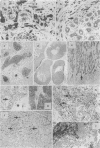Abstract
Tumour angiogenesis is a complex multistep process regulated by a number of angiogenic factors. One such factor, platelet-derived endothelial cell growth factor has recently been shown to be thymidine phosphorylase (TP). TP catalyses the reversible phosphorylation of thymidine to deoxyribose-1-phosphate and thymine. Although known to be generally elevated in tumours, the expression of this enzyme in breast carcinomas is unknown. Therefore, we used ribonuclease protection assays and immunohistochemistry to examine the expression of TP in 240 primary breast carcinomas. Nuclear and/or cytoplasmic TP expression was observed in the neoplastic tumour epithelium in 53% of tumours. Immunoreactivity was also often present in the stromal, inflammatory and endothelial cell elements. Although endothelial cell staining was usually focal, immunoreactivity was observed in 61% of tumours and was prominent at the tumour periphery, an area where tumour angiogenesis is most active. Tumour cell TP expression was significantly inversely correlated with grade (P = 0.05) and size (P = 0.003) but no association was observed with other tumour variables. These findings suggest that TP is important for remodelling the existing vasculature early in tumour development, consistent with its chemotactic non-mitogenic properties, and that additional angiogenic factors are more important for other angiogenic processes like endothelial cell proliferation. Relapse-free survival was higher in node-positive patients with elevated TP (P = 0.05) but not in other patient groups. This might be due to the potentiation of chemotherapeutic agents like methotrexate by TP. Therefore, this enzyme might be a prediction marker for response to chemotherapy.
Full text
PDF
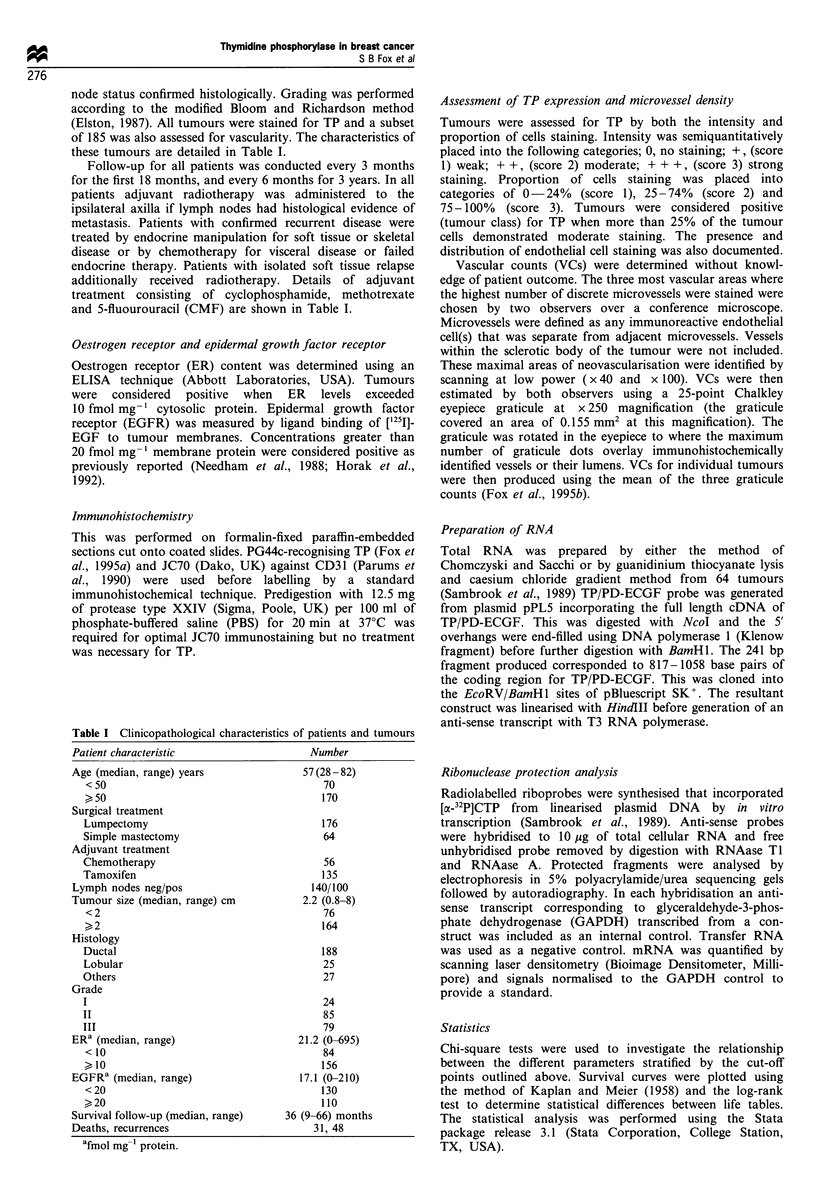
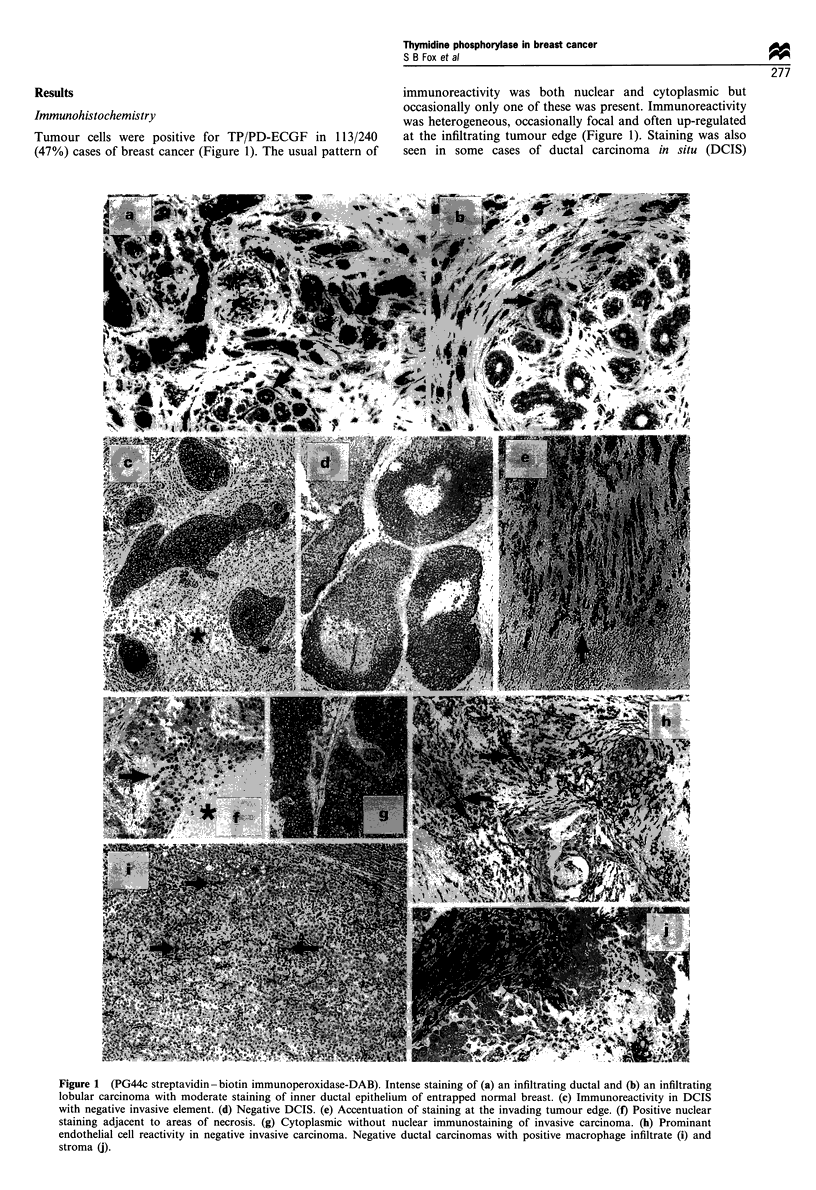
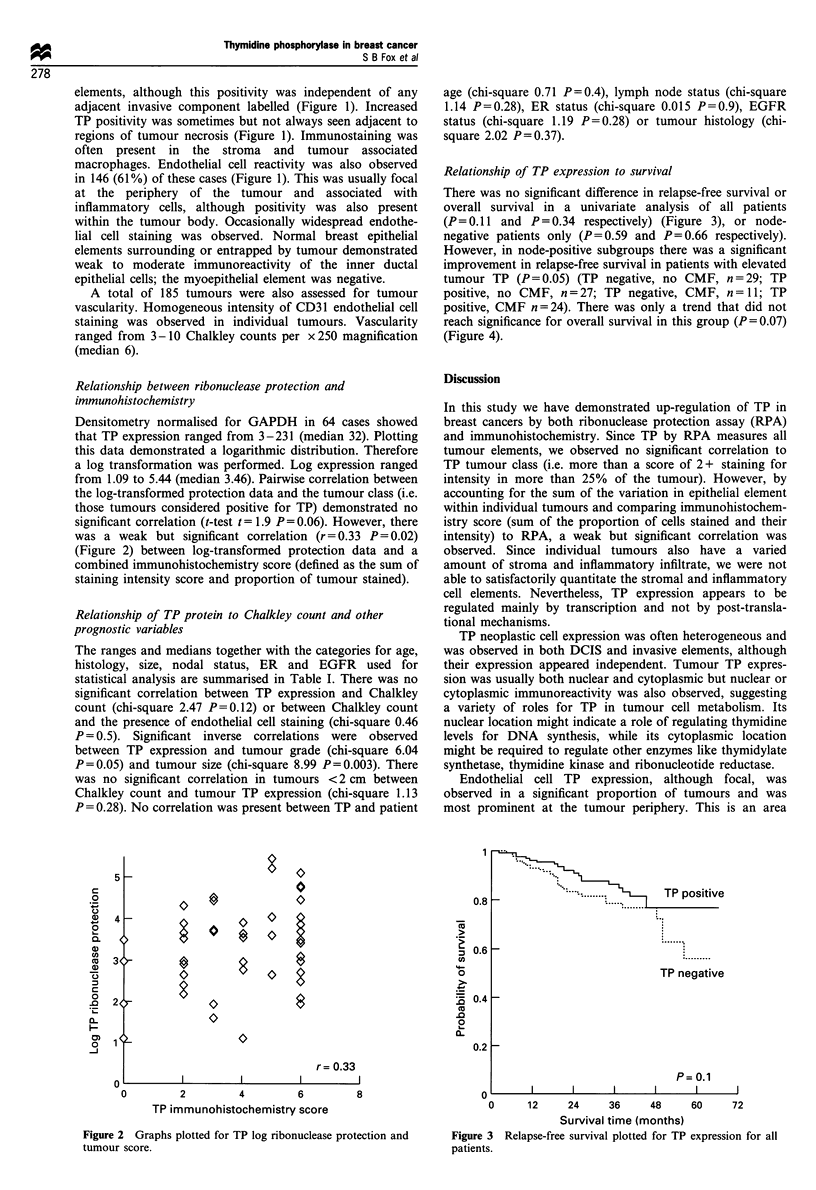
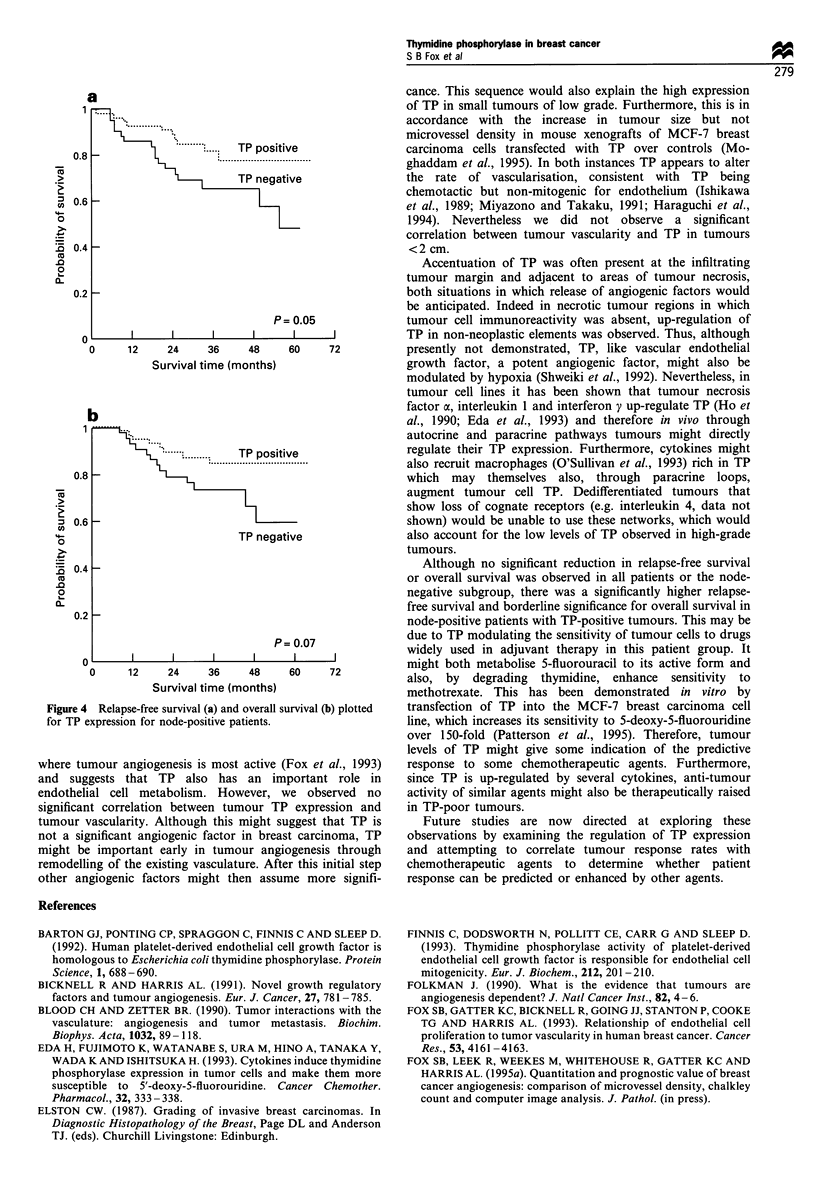

Images in this article
Selected References
These references are in PubMed. This may not be the complete list of references from this article.
- Barton G. J., Ponting C. P., Spraggon G., Finnis C., Sleep D. Human platelet-derived endothelial cell growth factor is homologous to Escherichia coli thymidine phosphorylase. Protein Sci. 1992 May;1(5):688–690. doi: 10.1002/pro.5560010514. [DOI] [PMC free article] [PubMed] [Google Scholar]
- Bicknell R., Harris A. L. Novel growth regulatory factors and tumour angiogenesis. Eur J Cancer. 1991;27(6):781–785. doi: 10.1016/0277-5379(91)90189-k. [DOI] [PubMed] [Google Scholar]
- Blood C. H., Zetter B. R. Tumor interactions with the vasculature: angiogenesis and tumor metastasis. Biochim Biophys Acta. 1990 Jun 1;1032(1):89–118. doi: 10.1016/0304-419x(90)90014-r. [DOI] [PubMed] [Google Scholar]
- Eda H., Fujimoto K., Watanabe S., Ura M., Hino A., Tanaka Y., Wada K., Ishitsuka H. Cytokines induce thymidine phosphorylase expression in tumor cells and make them more susceptible to 5'-deoxy-5-fluorouridine. Cancer Chemother Pharmacol. 1993;32(5):333–338. doi: 10.1007/BF00735915. [DOI] [PubMed] [Google Scholar]
- Finnis C., Dodsworth N., Pollitt C. E., Carr G., Sleep D. Thymidine phosphorylase activity of platelet-derived endothelial cell growth factor is responsible for endothelial cell mitogenicity. Eur J Biochem. 1993 Feb 15;212(1):201–210. doi: 10.1111/j.1432-1033.1993.tb17651.x. [DOI] [PubMed] [Google Scholar]
- Fox S. B., Gatter K. C., Bicknell R., Going J. J., Stanton P., Cooke T. G., Harris A. L. Relationship of endothelial cell proliferation to tumor vascularity in human breast cancer. Cancer Res. 1993 Sep 15;53(18):4161–4163. [PubMed] [Google Scholar]
- Fox S. B., Moghaddam A., Westwood M., Turley H., Bicknell R., Gatter K. C., Harris A. L. Platelet-derived endothelial cell growth factor/thymidine phosphorylase expression in normal tissues: an immunohistochemical study. J Pathol. 1995 Jun;176(2):183–190. doi: 10.1002/path.1711760212. [DOI] [PubMed] [Google Scholar]
- Furukawa T., Yoshimura A., Sumizawa T., Haraguchi M., Akiyama S., Fukui K., Ishizawa M., Yamada Y. Angiogenic factor. Nature. 1992 Apr 23;356(6371):668–668. doi: 10.1038/356668a0. [DOI] [PubMed] [Google Scholar]
- Haraguchi M., Miyadera K., Uemura K., Sumizawa T., Furukawa T., Yamada K., Akiyama S., Yamada Y. Angiogenic activity of enzymes. Nature. 1994 Mar 17;368(6468):198–198. doi: 10.1038/368198a0. [DOI] [PubMed] [Google Scholar]
- Heldin N. E., Usuki K., Bergh J., Westermark B., Heldin C. H. Differential expression of platelet-derived endothelial cell growth factor/thymidine phosphorylase in human lung carcinoma cell lines. Br J Cancer. 1993 Oct;68(4):708–711. doi: 10.1038/bjc.1993.414. [DOI] [PMC free article] [PubMed] [Google Scholar]
- Ho C. K., Ou B. R., Hsu M. L., Su S. N., Yung C. H., Wang S. Y. Induction of thymidine kinase activity and clonal growth of certain leukemic cell lines by a granulocyte-derived factor. Blood. 1990 Jun 15;75(12):2438–2444. [PubMed] [Google Scholar]
- Horak E. R., Leek R., Klenk N., LeJeune S., Smith K., Stuart N., Greenall M., Stepniewska K., Harris A. L. Angiogenesis, assessed by platelet/endothelial cell adhesion molecule antibodies, as indicator of node metastases and survival in breast cancer. Lancet. 1992 Nov 7;340(8828):1120–1124. doi: 10.1016/0140-6736(92)93150-l. [DOI] [PubMed] [Google Scholar]
- Ishikawa F., Miyazono K., Hellman U., Drexler H., Wernstedt C., Hagiwara K., Usuki K., Takaku F., Risau W., Heldin C. H. Identification of angiogenic activity and the cloning and expression of platelet-derived endothelial cell growth factor. Nature. 1989 Apr 13;338(6216):557–562. doi: 10.1038/338557a0. [DOI] [PubMed] [Google Scholar]
- Kono A., Hara Y., Sugata S., Matsushima Y., Ueda T. Substrate specificity of a thymidine phosphorylase in human liver tumor. Chem Pharm Bull (Tokyo) 1984 May;32(5):1919–1921. doi: 10.1248/cpb.32.1919. [DOI] [PubMed] [Google Scholar]
- Miyazono K., Takaku F. Platelet-derived endothelial cell growth factor: structure and function. Jpn Circ J. 1991 Oct;55(10):1022–1026. doi: 10.1253/jcj.55.1022. [DOI] [PubMed] [Google Scholar]
- Moghaddam A., Bicknell R. Expression of platelet-derived endothelial cell growth factor in Escherichia coli and confirmation of its thymidine phosphorylase activity. Biochemistry. 1992 Dec 8;31(48):12141–12146. doi: 10.1021/bi00163a024. [DOI] [PubMed] [Google Scholar]
- Moghaddam A., Zhang H. T., Fan T. P., Hu D. E., Lees V. C., Turley H., Fox S. B., Gatter K. C., Harris A. L., Bicknell R. Thymidine phosphorylase is angiogenic and promotes tumor growth. Proc Natl Acad Sci U S A. 1995 Feb 14;92(4):998–1002. doi: 10.1073/pnas.92.4.998. [DOI] [PMC free article] [PubMed] [Google Scholar]
- Morris P. B., Ellis M. N., Swain J. L. Angiogenic potency of nucleotide metabolites: potential role in ischemia-induced vascular growth. J Mol Cell Cardiol. 1989 Apr;21(4):351–358. doi: 10.1016/0022-2828(89)90645-7. [DOI] [PubMed] [Google Scholar]
- Needham G. K., Nicholson S., Angus B., Farndon J. R., Harris A. L. Relationship of membrane-bound tissue type and urokinase type plasminogen activators in human breast cancers to estrogen and epidermal growth factor receptors. Cancer Res. 1988 Nov 15;48(22):6603–6607. [PubMed] [Google Scholar]
- O'Sullivan C., Lewis C. E., Harris A. L., McGee J. O. Secretion of epidermal growth factor by macrophages associated with breast carcinoma. Lancet. 1993 Jul 17;342(8864):148–149. doi: 10.1016/0140-6736(93)91348-p. [DOI] [PubMed] [Google Scholar]
- Parums D. V., Cordell J. L., Micklem K., Heryet A. R., Gatter K. C., Mason D. Y. JC70: a new monoclonal antibody that detects vascular endothelium associated antigen on routinely processed tissue sections. J Clin Pathol. 1990 Sep;43(9):752–757. doi: 10.1136/jcp.43.9.752. [DOI] [PMC free article] [PubMed] [Google Scholar]
- Patterson A. V., Zhang H., Moghaddam A., Bicknell R., Talbot D. C., Stratford I. J., Harris A. L. Increased sensitivity to the prodrug 5'-deoxy-5-fluorouridine and modulation of 5-fluoro-2'-deoxyuridine sensitivity in MCF-7 cells transfected with thymidine phosphorylase. Br J Cancer. 1995 Sep;72(3):669–675. doi: 10.1038/bjc.1995.392. [DOI] [PMC free article] [PubMed] [Google Scholar]
- Pauly J. L., Paolini N. S., Ebarb R. L., Germain M. J. Elevated thymidine phosphorylase activity in the plasma and ascitis fluids of tumor-bearing animals. Proc Soc Exp Biol Med. 1978 Feb;157(2):262–267. doi: 10.3181/00379727-157-40034. [DOI] [PubMed] [Google Scholar]
- Pauly J. L., Schuller M. G., Zelcer A. A., Kirss T. A., Gore S. S., Germain M. J. Identification and comparative analysis of thymidine phosphorylase in the plasma of healthy subjects and cancer patients. J Natl Cancer Inst. 1977 Jun;58(6):1587–1590. doi: 10.1093/jnci/58.6.1587. [DOI] [PubMed] [Google Scholar]
- Reynolds K., Farzaneh F., Collins W. P., Campbell S., Bourne T. H., Lawton F., Moghaddam A., Harris A. L., Bicknell R. Association of ovarian malignancy with expression of platelet-derived endothelial cell growth factor. J Natl Cancer Inst. 1994 Aug 17;86(16):1234–1238. doi: 10.1093/jnci/86.16.1234. [DOI] [PubMed] [Google Scholar]
- Shweiki D., Itin A., Soffer D., Keshet E. Vascular endothelial growth factor induced by hypoxia may mediate hypoxia-initiated angiogenesis. Nature. 1992 Oct 29;359(6398):843–845. doi: 10.1038/359843a0. [DOI] [PubMed] [Google Scholar]
- Sumizawa T., Furukawa T., Haraguchi M., Yoshimura A., Takeyasu A., Ishizawa M., Yamada Y., Akiyama S. Thymidine phosphorylase activity associated with platelet-derived endothelial cell growth factor. J Biochem. 1993 Jul;114(1):9–14. doi: 10.1093/oxfordjournals.jbchem.a124146. [DOI] [PubMed] [Google Scholar]
- Usuki K., Heldin N. E., Miyazono K., Ishikawa F., Takaku F., Westermark B., Heldin C. H. Production of platelet-derived endothelial cell growth factor by normal and transformed human cells in culture. Proc Natl Acad Sci U S A. 1989 Oct;86(19):7427–7431. doi: 10.1073/pnas.86.19.7427. [DOI] [PMC free article] [PubMed] [Google Scholar]
- Usuki K., Saras J., Waltenberger J., Miyazono K., Pierce G., Thomason A., Heldin C. H. Platelet-derived endothelial cell growth factor has thymidine phosphorylase activity. Biochem Biophys Res Commun. 1992 May 15;184(3):1311–1316. doi: 10.1016/s0006-291x(05)80025-7. [DOI] [PubMed] [Google Scholar]
- Vertongen F., Fondu P., van den Heule B., Cauchie C., Mandelbaum I. M. Thymidine kinase and thymidine phosphorylase activities in various types of leukaemia and lymphoma. Tumour Biol. 1984;5(6):303–311. [PubMed] [Google Scholar]
- Yoshimura A., Kuwazuru Y., Furukawa T., Yoshida H., Yamada K., Akiyama S. Purification and tissue distribution of human thymidine phosphorylase; high expression in lymphocytes, reticulocytes and tumors. Biochim Biophys Acta. 1990 Apr 23;1034(1):107–113. doi: 10.1016/0304-4165(90)90160-x. [DOI] [PubMed] [Google Scholar]
- ZIMMERMAN M., SEIDENBERG J. DEOXYRIBOSYL TRANSFER. I. THYMIDINE PHOSPHORYLASE AND NUCLEOSIDE DEOXYRIBOSYLTRANSFERASE IN NORMAL AND MALIGNANT TISSUES. J Biol Chem. 1964 Aug;239:2618–2621. [PubMed] [Google Scholar]



